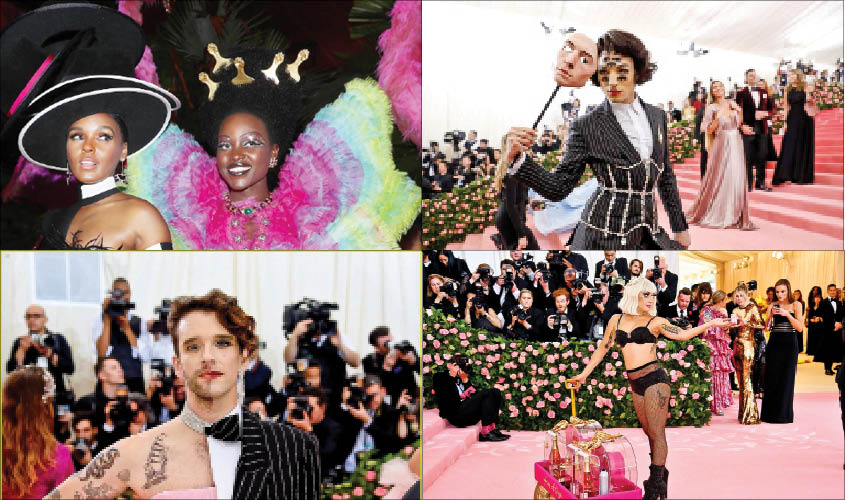Trying to define camp is like attempting to sit in the corner of a circular room.
—Andy Medhurst, Senior Lecturer in Film, Media and Cultural Studies at the University of Sussex
This year’s Met Gala theme, “Camp: Notes on Fashion”, paid homage to the queer community—a demographic that the world of fashion once frowned upon. Taking inspiration from Susan Sontag’s 1964 essay, “Notes on Camp”, which in 58 bullet points defines camp as “love of the unnatural: of artifice and exaggeration”, the 2019 edition of Met Gala, as well as the costume exhibition that followed it, was an unprecedented celebration of camp style, beginning with one of the most iconic red-carpet, or, in this case, pink-carpet events.
“The hallmark of Camp is the spirit of extravagance,” reads Sontag’s essay that described this concept as an “esoteric or a private code,” a definition that has become so ubiquitous that it somehow betrays its own origins. While Sontag doesn’t dwell upon queerness in her essay, the fact remains that the origins of everything camp lie rooted in the gay community and the unrestrained self-expression of the queer identity.
As early as 1909, camp was defined as “ostentatious, exaggerated, affected, theatrical; effeminate or homosexual” in the Oxford Dictionary. Today, it stands as a reminder of every cultural limitation surpassed. This bewildering theme has a rich history of feminism, queerness, politics and ethos that challenge the very basic structures of the binaries binding gender. With centuries of history behind it, camp cannot be contained in one definition as the power and liberation it offers can only be seen and felt.
Historically, the origins of camp can be traced back to 17th-century France, where the expression se camper meant “posing boldly”. But subsequent developments transformed it into a tool with which the queer community could reclaim the cultural space denied to them. It became a medium of queer liberation.
Especially, queer men used camp style—in art and fashion—to appropriate the stereotypes that oppressed them. For example, even as fashion enabled gay men to embrace the notion of them being effeminate or womanly, queer folk began using camp as a way to claim the space denied to them in heteronormative cultures.
The ball culture or drag ball culture (a talent competition where participants walk and pose in elaborate, self-styled costumes) which, some say is the birthplace of camp, emerged in the 1920s around New York City. Initially the performers were all white men putting up drag fashion shows and black queens rarely participated. When the latter did, they were expected to paint their faces white. Tired of the oppression and blatant racism, the queer black ball community established their own underground ball culture in the 1960s. This was met with violent opposition and many queer people of colour stood up to the police (New York’s Stonewall riots). Balls became a safe space for queer youths of colour and thus camp became a performance art meant to laugh at the face of moral sanctions.
Looking at this year’s Met Gala pink carpet, one could see the boundaries of gender dissolving and giving way to a wacky, out-of-the-world aesthetic that is perverse, loud, unabashed and unapologetically liberated. Be it Ezra Miller and Michael Urie’s gender-defying look or Billy Porter’s larger-than-life stature, camp posed a challenge to rampant toxic masculinity, which to this day continues to shape the lives of men in violent and aggressive ways. It allowed Lady Gaga, Cardi B., Janelle Monae and Priyanka Chopra to step out of the culture of patriarchy. However deviant, camp allows women of colour to rebel against the docile, subservient mould created for them, and gives men the freedom to celebrate who they are.
Lena Waithe with the suit she wore at Met Gala—printed on its back was “BLACK DRAG QUEENS INVENTED CAMP”—gave due credit to the real inventors of camp. Embossed on the pinstripes of the suit were song lyrics, from anthems like Diana Ross’ “I’m Coming Out”.
Speaking on the essence of camp, Randy Scarhol, an Indian Drag Queen and trans model says, “Camp glorifies queerness and flamboyance, but it does so with a sense of strong departure from the elite man’s definition of art. It is a form of defiance from the snooty, pretentious art circles that were ruled by heteronormative ideas. It is a performance art that is very queer, gaudy, hideous and almost ugly. It has a very strong sense of comedy in it.”
When asked about the potential danger of queer culture being appropriated at elite events, she says, “The Met Gala at its core is a charity fundraiser in an elite circle. So of course, people with a strong queer representation could have been invited but were not. But personally, I am very conflicted about the entire issue as change and awareness never come easy. Even outside of camp a lot of queer art is appropriated, but at the same time even if a single queer life is liberated and given due credit, it is a desirable change.”
The queering of contemporary cultures often takes place through direct appropriation and its merger with heteronormative ideas. It will be interesting to see if these practices turn out to be liberating or oppressive for the community. For now, camp stands at a danger of turning into an appealing method for reframing queer cultural practices and for providing a false sense of civil liberties to queer individuals and the community at large.

